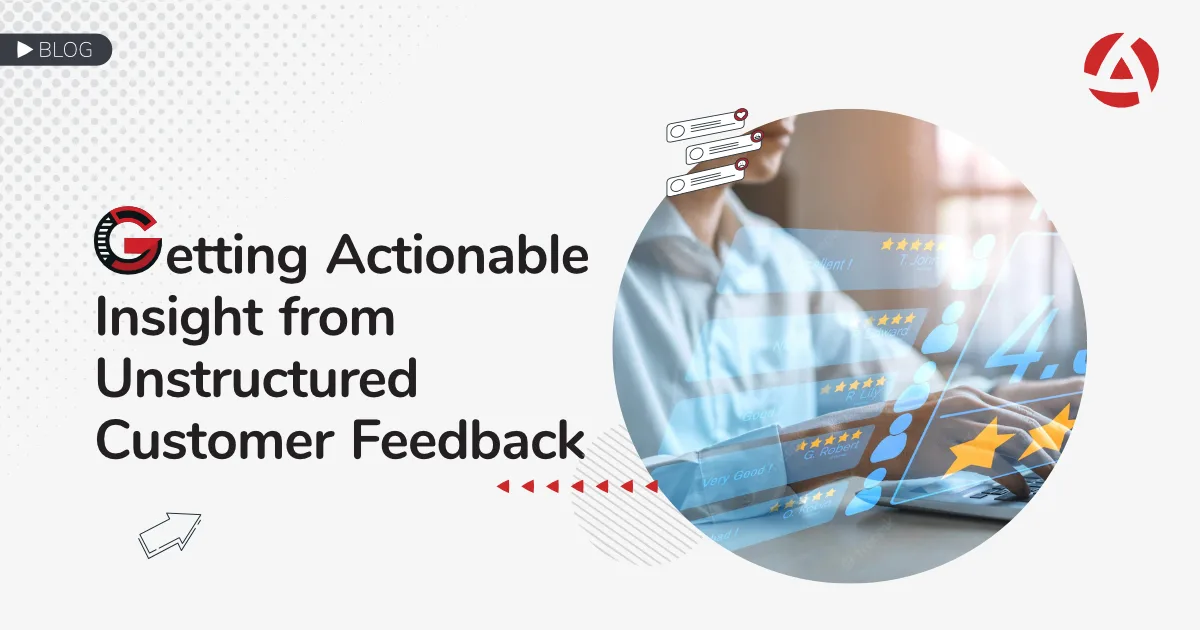Unlock Customer Experience Through Unstructured Feedback
Many customers want to tell you what they think and how they feel. Are you really listening to them? Most likely your answer is “YES” and you’re not alone! It is fair to say that companies have become better at listening to their customers in recent years. How deep do you dive into customer feedback? How do you rate customer feedback importance? What customer feedback tools do you use? Are you only looking at your star ratings or are you collecting customer feedback from everywhere, continuously and in all formats? Extracting meaningful insight and turning them into actions is very challenging in today’s complex CX space. Here are some tips for unlocking actionable insights through unstructured feedback.
Do we need all the customer feedback?
According to projections from IDC analysts, over 80 percent of all customer feedback will be in an unstructured format by 2025 (E-mails, online reviews, social media posts, survey comments, recorded phone calls etc.). Understanding customer satisfaction and expectation without exploring the unstructured data or without a variable customer feedback management is like trying to complete a puzzle that’s missing a piece. It is a challenge to manage loads of company comments and reviews across platforms.
How will we get insight out of unstructured feedback?
You can analyze structured data (received from surveys) through simple statistical methods. Unstructured data is harder to understand for many reasons: allusions, many unrelated ideas, grammatical errors, misspellings, and unclear sentiments. Therefore, a certain customer feedback system may be needed when making such analysis. The simplest way to understand unstructured customer feedback is to have trained staff read and categorize all feedback responses. If the company is receiving a few hundred surveys a week, this approach of customer feedback analysis might work. However, it does not scale well when the numbers start to increase. You may begin to face some trouble because of limited staff resources, human error creeps in, and of course, let’s not forget the increasing cost. What if there were a way to read, categorize and analyze unstructured data under the framework of a special customer feedback method? Text analytics does this precisely: Determine which topics are on your customers’ minds and trigger actionable insights.
How does text analytics work and how do we get benefit from it?
Action-oriented text analytics is sometimes confused with sentiment analysis. They are both ways to derive meaning from unstructured customer feedback, yet each has its distinct purpose. Sentiment analysis classifies expressions as positive, negative, or neutral. For example, the statement, “The hotel is in a great location with a fantastic view of the city,” contains positive words such as “great” and “fantastic.” Now consider a similar sentence: “Fantastic location and a great view, ya right.” The same positive words appear, but the customer is using sarcasm to make a negative point. Most often, sentiment analysis using simple techniques may not distinguish nuance in these customer feedback examples. On the other hand, customer feedback software containing action-oriented text analytics can use natural language processing (NLP) and machine learning to identify the parts of a text, learn which words and ideas are linked, automatically correct mistakes, and transform these functions into actionable insights. Let’s consider a customer feedback example. A customer went in for a test drive at a car dealership. After the experience, the customer may have some comments. It can be about the test drive itself generally, or it can be about something particular, such as the duration of the drive. With text analytics operating in customer feedback software, the automobile manufacturer can differentiate the comment and the dealership. The software can enable an automated notification to trigger an improvement task. The concerned manager can then take action to resolve and even prevent future issues. Advanced text analytics has made it possible for companies to automatically process customer feedback and take fast action on loads of unstructured customer feedback at a much lower cost than ever before! To learn more about text analytics, have a look at Our Product page to see it in action.
FAQ
Why Unstructured Feedback is Important?
Unstructured customer feedback and relevant key issues may provide essential input to your company’s marketing strategy, such as:
- Better understand your target audience
- Analyze your customers’ perceptions
- Manage a product launch
- Innovate regularly
- Optimize customer experience and services
- Improve product features
- Feed the customer relations department
How Can Unstructured Feedback Be Used?
Customer feedback in the form of reviews and ratings, social media comments, chat logs, and spontaneous e-mail messages has become an extremely valuable asset to the success of your business. Encouraging and collecting customer feedback, particularly in an unstructured format should be an integral part of any business communication strategy so as to:
- Identify areas that require immediate action
- Translate customer feedback into product and service innovations
- Integrate customer feedback into your communication materials
- Identify your promoters and turn them into referral sources
- Remotivate your employees




